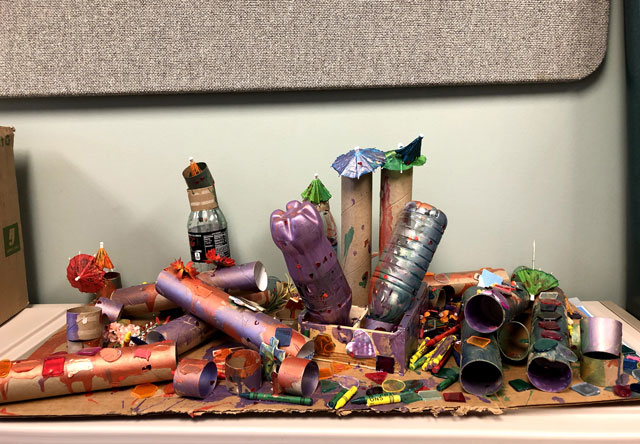When young children create visual art, they explore and experiment with the properties of materials. Some classic examples of developmentally appropriate art opportunities for children include drawing with crayons, painting at an easel, or creating a paper collage. These types of art experiences allow children the opportunity to explore in two dimensions of space.
Through these experiences, children express their ideas and develop an understanding of the various elements of design including line, shape, and color. Children develop fine motor coordination with their hands, develop their ability to focus on a task and share their ideas through both their artwork and conversations about their creations.
Young artists can also work with three-dimensional (3-D) media. Adding a third dimension of physical space allows young artists to explore design properties in new ways. Three dimensional materials allow children to design with length, width, and depth. Working in three dimensions provides new challenges for young artists. For example, when children create in 3-D, they must choose the most appropriate media for their purpose, balance the objects in their creations, and problem-solve how to attach materials.
Neighborhood walks can be a great source of inspiration to children as they discover 3-D forms. They have likely encountered statues and sculptural elements in the built environment and natural forms in the rocks, trees, and other plants in their surroundings. Observing these forms can be a springboard for their 3-D creations.
When early childhood teachers and caregivers seek to move from making product-oriented “crafts” to more process-focused art opportunities, it helps to begin simply. For example, one might provide children with tempera paint and kitchen tools such as spoons, potato mashers, and forks and allow them to discover the possibility of painting with objects other than brushes.
Similarly, it helps to start small with 3-D materials. Children can be provided with flexible wire and wooden beads so they can figure out what types of shapes they can create and how the position of the beads might change if the wire is bent in different directions. They might be given clay or playdough with wooden sticks and figure out how to attach the two to build structures.
Teachers and caregivers can actively scaffold children’s thinking and experimentation by modeling how the materials might work together, commenting on children’s tries at using the materials, and providing children multiple opportunities with a set of materials to develop their familiarity and skill in using these materials. You may be surprised by what you can create!
New techniques such as sewing and lacing fabric, bending and forming shapes with wire, or working in clay can be introduced as children become familiar with creating in 3-D. The process of creation should be the focus of the activity rather than the outcome, just as it is with paintings, drawings, and other two-dimensional creations. It is possible for children to create objects with a specific purpose in mind, such as a costume that can be worn during dramatic play or a representation of a building they have observed. However, it is not necessary that a product be planned. Children can be given materials that they can experiment with in three dimensions, and, through the process of trial and error, they can become familiar with their properties and discover the possibilities of what they can create.

Rebecca Swartz
Dr. Rebecca Swartz is an assistant professor in the Department of Teaching and Learning at Southern Illinois University Edwardsville. She teaches courses in the early childhood education program including courses on early language and literacy, early mathematics, and collaboration with families. Prior to coming to SIUE she was an early learning specialist on state early childhood projects in the Department of Special Education at the University of Illinois at Urbana-Champaign.
Biography current as of 2022
IEL Resources
- Resource List: Explore the Visual Arts with Young Children
- Resource List: Explore STEAM with Young Children
- Blog: Make Art a Part of Every Day: Focus on the Process


